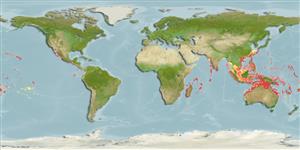>
Mulliformes (Goatfishes) >
Mullidae (Goatfishes)
Etymology: Parupeneus: Latin, parum, parvum = small + Peneus, the name of a river.
More on author: Lacepède.
Environment: milieu / climate zone / depth range / distribution range
Ecologia
marino associati a barriera corallina; distribuzione batimetrica 2 - 91 m (Ref. 26165), usually 2 - 40 m (Ref. 37816). Tropical; 30°N - 30°S
Indo-Pacific: western Indian Ocean to the Line, Marquesan, and Tuamoto islands, north to southern Japan, south to Australia and Rapa. Replaced by Parupeneus porphyreus in the Hawaiian Islands (Ref. 37816).
Size / Peso / Age
Maturity: Lm ? range ? - ? cm
Max length : 38.0 cm TL maschio/sesso non determinato; (Ref. 9710); peso massimo pubblicato: 2.3 kg (Ref. 4887)
Spine dorsali (totale) : 8; Raggi dorsali molli (totale) : 9; Spine anali: 1; Raggi anali molli: 7. Diagnosis: Pectoral rays 15 (rarely 14 or 16); gill rakers 6-8 + 23-27 (total 30-34); body depth 2.93.5 in SL; head length (HL) 2.85-3.25 in SL; dorsal profile of snout straight to slightly concave, the snout length 1.85-2.1 in HL; barbels short, 1.5-1.8 in HL; longest dorsal spine 1.55-1.9 in HL; last dorsal ray slightly longer than penultimate ray; posterior margin of caudal-fin lobes convex; pectoral-fin length 1.35-1.55 in HL; pelvic-fin length 1.2-1.55 in HL. Color brown to red dorsally, paler ventrally, the scale edges darker; scales on body with or without a white or pale blue spot; a darker brown or brownish red stripe, broadly bordered in white, from front of snout through center of eye, becoming indistinct below origin of second dorsal fin; a dark brown spot within stripe behind eye; a second dark stripe across cheek parallel to the first, bordered below by a white band that ends at pectoral-fin base; a white or pale pink spot anteriorly on upper half of caudal peduncle covering about three horizontal rows of scales, followed by a black or dusky spot with darker scale edges a little larger in size (spot may extend slightly below lateral line); fins light red to reddish gray, the second dorsal and anal fins often with small pale spots (Ref. 54393).
Occurs in seagrass beds and coralline areas of lagoon and seaward reefs. Feeds on benthic invertebrates, mostly crustaceans, at night.
Life cycle and mating behavior
Maturities | Riproduzione | Spawnings | Egg(s) | Fecundities | Larve
Randall, J.E., 2004. Revision of the goatfish genus Parupeneus (Perciformes: Mullidae), with descriptions of two new species. Indo-Pac. Fish. (36):64 p. (Ref. 54393)
IUCN Red List Status (Ref. 130435)
Threat to humans
Harmless
Human uses
Pesca: commerciale; Pesce da pesca sportiva: si
Strumenti
Special reports
Download XML
Fonti Internet
Estimates based on models
Preferred temperature (Ref.
123201): 24.3 - 28.9, mean 27.6 °C (based on 1374 cells).
Phylogenetic diversity index (Ref.
82804): PD
50 = 0.5000 [Uniqueness, from 0.5 = low to 2.0 = high].
Bayesian length-weight: a=0.01096 (0.00700 - 0.01716), b=3.13 (3.00 - 3.26), in cm total length, based on LWR estimates for this species & Genus-body shape (Ref.
93245).
Trophic level (Ref.
69278): 3.5 ±0.0 se; based on diet studies.
Resilienza (Ref.
120179): Medio, tempo minimo di raddoppiamento della popolazione 1.4 - 4.4 anni (Preliminary K or Fecundity.).
Fishing Vulnerability (Ref.
59153): Low to moderate vulnerability (28 of 100).
Nutrients (Ref.
124155): Calcium = 30.8 [15.8, 68.0] mg/100g; Iron = 0.299 [0.152, 0.660] mg/100g; Protein = 17.9 [14.5, 20.9] %; Omega3 = 0.127 [0.073, 0.231] g/100g; Selenium = 58.4 [28.6, 132.5] μg/100g; VitaminA = 190 [39, 787] μg/100g; Zinc = 0.52 [0.31, 0.99] mg/100g (wet weight);
